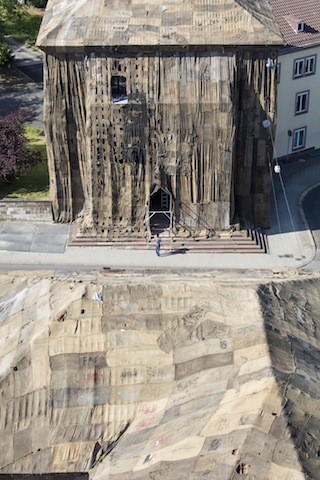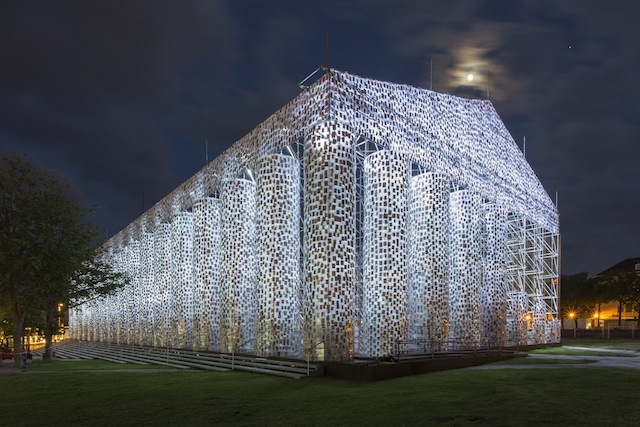Political urgency is no less present in the quinquennial’s second chapter
So now the second half of Documenta 14 has opened. And the first question that arises is whether Kassel has succeeded in connecting to the opening of its first ‘chapter’ in Athens – whether, and how, the lines of questioning posed in Athens continue in the second instalment.
Kassel’s many works in the public space already affirm this question – these sculptures and installations continue the artistic confrontations with topics like ‘the endangerment of democracy’ ‘neoliberal globalisation’ and ‘refugee crisis’. Marta Minujín’s Parthenon of Books (1983/2017) for example, is a scaffold that recreates the Parthenon in Athens at a one-to-one scale. This scaffold is now meant to be filled with books that are or were censored, donated in part by viewers of Documenta 14. Banu Cennetoğlu’s intelligent installation on the Fridericianum facade deals not with the global degradation of fundamental democratic rights, but rather with the ambivalent relationship between security and threat. The Turkish artist has placed the seemingly paradoxical sentence ‘Being safe is scary’ in large metal letters on the building’s portal. Ibrahim Mahama addresses economic structures of neoliberal globalisation and their effects on third-world countries by wrapping Kassel’s historical Torwache (gate watch), whose two towers are now essentially camouflaged in sewn fabric. The work, titled Check Point Sekondi Loco. 1901–2030. 2016–2017 (2016–2017), simultaneously tells of production and trade in our current phase of capitalism – the jute sacks wrapping the structure are made in Asia but are meant for packaging coffee, cocoa and rice in, for example, Ghana; commodities that then get exported to Europe, America and elsewhere. In Athens, Mahama placed these sacks temporarily on Athens’ Syntagma Square (also known as Constitution Square), which in the past few years has been the centre of resistance against austerity measures implemented upon the Greek government. Olu Oguibe discusses the refugee crisis with his concrete obelisk Das Fremdlinge und Flüchtlinge Monument (Monument for strangers and refugees, 2017), onto which, in four languages, the artist has written ‘I was a stranger and you took me in’ – a modification of the phrase ’I was a stranger you took me not in’ attributed to Jesus Christ in the Bible’s book of Matthew. All of these works are nearly monumental, yet still loaded with political meaning and are thus convincing examples of ‘critical populism’ – a kind of art which is both easy to understand and critical engaged.

At the Fridericianum, Documenta’s central and tradition-laden exhibition hall, curator Adam Szymczyk has invited the National Museum of Contemporary Art in Athens (EMST) to present an exhibition drawn from its permanent collection. On view here is the exhibition curated by Katerina Koskina, the director of the Museum, displaying works by established artists such as Jannis Kounellis and Jan Fabre, alongside with works by Greek artists less well-known to international audiences and younger international artists like Emily Jacir or Oliver Ressler. This collection has never been on view; in Athens there’s not enough funding to do so. So instead of engaging in a kind of cultural imperialism (which this Documenta has been accused of) D14’s temporary move of the Greek collection to Kassel helps grant it visibility – a smart gesture by Szymczyk, which shows that exchange can consist of more than mere networking to one’s own advantage.

In Kassel’s Neue Galerie is another unique selling point of this leg of D14. Here, one theme arises that was not on view in Athens, namely the question of German National-Socialist history and its long-lasting (and still present) effects in Germany, issues still often taboo and largely repressed in mainstream German discourse. A crucial work in this context is Maria Eichhorn’s installation Rose Valland Institut (2017), which interrogates the property issues behind things that once belonged to Jewish people. In the centre of the installation is a six-metre-high bookshelf containing books from the Berlin state library. These books have two things in common: Nazis confiscated them from Jewish citizens, and their true owners have still not been identified. Additionally, Eichhorn launched ‘Open Call: Unlawful Ownership in Germany’, with which she instigates a search for objects that the Nazis plundered. The Rose Valland Institute is perhaps not particularly exciting in the sensual, aesthetic sense, but the work embodies an astonishing degree of critical engagement – typical for this Documenta, which successfully continues to reflect on politically urgent questions such as the refugee crisis, neoliberal globalisation and rightwing politics.
Online review 13 June 2017
